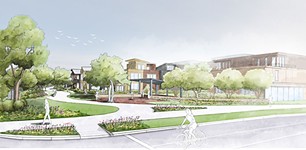Point Austin: All Grove All the Time
In Austin's housing toolbox, all we've got are hammers
By Michael King, Fri., Oct. 7, 2016

In late September, the White House released a "Housing Development Toolkit," an attempt to address the nationwide crisis in housing affordability: "The growing severity of undersupplied housing markets," reports the white paper, "is jeopardizing housing affordability for working families, increasing income inequality by reducing less-skilled workers' access to high-wage labor markets, and stifling GDP growth by driving labor migration away from the most productive regions."
Sound familiar? The report is generating local buzz, not only because Austin is among "the high-growth metropolitan areas increasingly fueling the national economy," but because the findings suggest that it's not just growth driving high housing prices. The unnamed authors report that restrictive city policies, including "zoning, other land use regulations, and unnecessarily lengthy development approval processes [have] reduced the ability of many housing markets to respond to growing demand." (Austin gets a passing nod for its S.M.A.R.T. Housing program, enabling 4,900 affordable units since 2005.)
Overall, the report paints a grim picture of the current housing market. "Locally-constructed barriers to new housing development include beneficial environmental protections, but also laws plainly designed to exclude multifamily or affordable housing. Local policies acting as barriers to housing supply include land use restrictions that make developable land much more costly than it is inherently, zoning restrictions, off-street parking requirements, arbitrary or antiquated preservation regulations, residential conversion restrictions, and unnecessarily slow permitting processes. The accumulation of these barriers has reduced the ability of many housing markets to respond to growing demand."
Yes, but ...
That's a reasonably fair summation of the Austin situation. Nevertheless, likely to raise hackles in local quarters are several recommendations in the "toolkit": The 10 recommended "tools" (drawn from what the report describes as best local practices) include strategies both used and abhorred in Austin.
• Establish by-right development [i.e., meeting existing zoning requirements merits project approval]
• Tax vacant land or donate it to non-profit developers
• Streamline or shorten permitting processes and timelines
• Eliminate off-street parking requirements
• Allow accessory dwelling units
• Establish density bonuses
• Enact high-density and multifamily zoning
• Employ inclusionary zoning
• Establish development tax or value capture incentives
• Use property tax abatements
Several of these methods are used in Austin. Density bonuses (additional entitlements in return for affordable units) have been in place for several years, although with limited results. The city is trying to streamline permitting processes, investing additional resources it hopes to recoup directly from developers (we'll see). The current City Council has encouraged accessory dwelling units (aka "granny flats"). Inclusionary zoning – rigidly controlled by state law – is in Austin essentially euphemised as density bonuses.
Varieties of No
By contrast, the outcry whenever there's talk of eliminating off-street parking requirements has generally made such policies nonstarters, angrily denounced by folks who believe "free parking" is a divinely granted right rather than an oxymoron, and a major driver of both direct construction and indirect opportunity costs. And the notion of "by-right" development – abbreviating the currently repetitive administrative, commissions, Council, and public review of any project that arouses virtually any opposition – flies in the face of decades of Austin political practice.
I share skepticism about strictly administrative approvals, which could grant too much deference to the letter of zoning ordinances when specific project circumstances might dictate adjustments or variances. But in Austin right now, that danger seems frankly remote. For current example, Council devoted its entire Tuesday work session to a single aspect of what is now apparently the only important issue in town – the proposed Grove PUD – and expects to devote much of the next few weeks doing the same. Is it really a useful occupation for the city's policymakers to spend hours debating with professional traffic engineers the best way to implement bike lanes near a proposed development? (And in a neighborhood that has previously rejected such lanes, in preference for – you guessed it – free parking.)
If we're going to make real progress on bending the Austin cost curve, we've got to find some political middle ground that enables a substantial increase in the overall housing supply, affordable and market-rate alike. The White House report reflects that nationwide, while base construction costs have remained essentially steady for the last three decades, real prices for that housing continue to spike – and further, that "stringent housing regulations [are] now driving cost increases previously shaped by construction costs and quality improvements."
That is, every politically aggravated ordinance, debate, delay, duplicate review, or ideological lawsuit over necessary residential development doesn't just cost the "Evil Developer" – it costs every last one of us. One can hope for some broader public realization, but somehow I doubt this latest admonition from the White House will have much salutary effect on the Austin housing crisis.
The "Housing Development Toolkit" is available at www.whitehouse.gov/sites/whitehouse.gov/files/images/Housing_Development_Toolkit%20f.2.pdf. Follow @PointAustin.
Got something to say on the subject? Send a letter to the editor.










